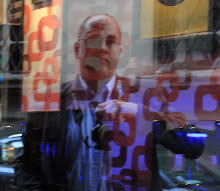
For the first time in three tries, it was not raining when I visited Siena. The last two times I brought students here, the stones were slick and the breaks in the rain were spotty. But, now that I remember, it just wasn't that bad. Siena is a charmer, and in my book, not only is that a good thing, but a bit of rain here or there is not going to diminish the experience much. It was here, five years ago, that I stood under the boards laid out on a high, rambling structure of scaffolding clinging to an ancient structure, and read Invisible Cities while waiting for the rain to stop. It's all part of the experience.
Siena is an experience. It's one of those places that transport you back to the 14th century, especially when you get out in the lesser traveled areas of town. Especially, especially if you stay after dark. This time the weather was beautiful, with blue skies and warm temperatures each day. We went to the Duomo, looked at the designs on the floor and the Museo del Opera del Duomo to see the original sculptures that were on the outside and Duccio's Maesta. Each time I see it I think of the the day when the painting was brought to the cathedral, when all the shops closed down, the populace lined the streets and followed the procession, alms were given out and the city solemnly installed the painting on the high altar. There is a diagram showing the original position of all the panels, front and back, and it is sad to think of it being taken down in the 1700s and sawn into pieces, with some pieces damaged, others sold off, and others lost.
It's fun to look around the city for the contrada symbols as you walk from one division of the city to another. This time I poked my hand on the metal tusks of an elephant's head- one of the supports of the stair-rail going up the steps to the fountain next to the contrada hall of the Contrada della Torre. There above you on the walls, are emblems of a caterpillar, or a panther, or a tortoise.
The next day we went to the museum at the Palazzo Pubblico, especially to see the fresco paintings The Effects of Good and Bad Government by Ambrogio Lorenzetti in the room where the city's leaders, the Nove, met. We drew for a while from the overlook in the back of the palace. There is a big staircase in the middle of the rooms, and if you go up to the top, you can go through the doors and look out on the marketplace below and out to the countryside beyond. The countryside doesn't look all that different from that depicted in the painting- thankfully, on the side of good government.
By seven at night, most of the crowds are gone and the Campo, where the Palio is held, is much emptier. Sometimes, on warm days, as the night comes on, a cool breeze comes up the hill and through the gates and over the walls. The streets become lit here and there with lights above and coming through doorways and windows. The few cars and small shuttle buses you encounter during the day have been reduced down to none at all. And, if you squint, the neon lights from the gelaterie fade, the bright electric lights inside the bar almost becomes torchlight, and you are transported.

My Italian Renaissance class is coming back to me through your post! I'm so jealous.
ReplyDelete